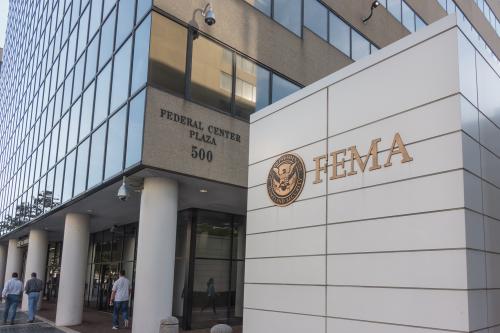As U.S. metropolitan leaders return to domestic realities after COP26, the United Nations climate summit, they face a glaring contradiction.
At the Glasgow summit, leaders were bolstered by the renewed conviction that cities are centers of progress on climate action. However, they were also rebuked by waves of new research detailing massive gaps between countries’ long-term promises to zero out carbon emissions and their official near-term plans. For example, the summit was roiled last week by a Washington Post analysis showing that many countries grossly underreport their greenhouse gas (GHG) emissions—meaning that the world is relying on flawed data.
All of which underscores the need for cities and metropolitan areas to bear down and square their tremendous potential to reduce carbon emissions with new efforts to deliver. And as recent and forthcoming Brookings research emphasize, metro areas have much work to do if they are to act on the sense of urgency emanating from Glasgow.
Forthcoming work from Brookings Metro’s Joseph W. Kane and Adie Tomer stresses the need for improved measurement and data collection if the U.S. is to tap the power of capital markets to deliver more resilient outcomes, particularly for the transportation, water, and real estate sectors. This follows on their work emphasizing the importance of measuring both the costs and benefits of climate action. In the meantime, it bears looking again at last year’s Brookings assessment of the nation’s many city-based Climate Action Plans (CAPs). That work, conducted before the pandemic based on data from 2017, suggests that cities’ well-intentioned GHG emissions targets, reduction strategies, and monitoring efforts often suffer from some of the gaps, drift, and slippage of country-level commitments.
Led by Sam Markolf of the University of California, Merced and Inês Azevedo of Stanford University, the assessment looked at the 100 largest U.S. cities and found that, as of 2017, only 45 had any serious climate pledge at all—and that many of the pledges that did exist remained heavier on aspiration than reality. In this regard, about two-thirds of the pledging cities are currently lagging their targeted emissions levels, while 13 others don’t appear to have available emissions tracking in place. What’s more, only six of the plans encompass smaller communities in the bottom quartile of cities. Most glaringly, the GHG targets set by cities are mostly nonbinding, with the exception of those in California.

In short, while these efforts added up to a meaningful 6% or so trimming of total U.S. emissions in 2017, the reductions fell far short of the targets that the Intergovernmental Panel on Climate Change (IPCC) says are needed to avoid some of the worst impacts of climate change. Though additional city-based action has occurred since 2017, the story today is likely not massively different.
As to what needs to happen now, CAP activity needs to expand, with new commitments to improved data collection, measurement, and execution. In this regard, the great potential of city-based “bottom-up” climate action can be better realized if municipalities, states, the federal government, nongovernmental organizations, philanthropies, and companies work to:
- Put in place more plans. Although more than 600 local governments in the U.S. have developed CAPs that include GHG inventories and reduction targets, it’s not enough. More action is needed, especially among larger cities, but also in small ones. Consideration and action around a broader set of climate adaptation needs are also needed given the uneven and costly impacts currently hitting communities.
- Improve the quality of pledges. Activists and politicians have focused a lot on bold announcements, which have a role to play. However, pledges need to include more focus on how emissions will be reduced, including on how those efforts will be sustained. Philanthropy may have a role to play.
- Emphasize implementation. If Glasgow underscored one thing, it’s that commitments need to be backed up with far grittier implementation plans than has been the case so far. In general, cities should put more focus on implementation than aspiration, and stress how they are turning pledges into reality. Just as how more nongovernmental organizations are doing detailed comparisons between nations’ plans, a focus on implementation should spread through cities too. Regular, rigorous monitoring, accounting, and implementation assessments should become the norm. If they don’t—and localities continue to make pledges that lack a genuine plan of action—it could quickly erode public trust.
- Improve measurement and data collection. As the management-school adage goes, only “what gets measured, gets managed.” Yet in most cities, managers are operating with flawed, partial, or nonexistent data on whether their CAPs are delivering true emissions reductions. For example, 13 of the CAPs Brookings studied lacked available GHG inventories for years after their establishment. Given that, more data and better modeling are essential. Increased use of earth observation satellites is one advancement that will soon deliver more accurate monitoring. Meanwhile, a large community of energy systems modelers with powerful tools exists, but has not for the most part been engaged to focus on cities. Beyond energy, there needs to be more consistent evaluations of related infrastructure improvements at a regional scale, as demonstrated by the Natural Capital Project. These resources and strategies should be fully leveraged, as improved measurement and data collection will be essential to change outcomes in the next decade.
- Encourage learning. To further convert aspiration into delivery, stronger mechanisms for peer review and the sharing of best practices are badly needed so that the community of activists and planners can learn—faster—what works and what doesn’t, and adjust accordingly. Part of this process must include the publication of more detailed and transparent information about what cities are trying, but it also requires systematic review and frank discussion of what is working and what is failing. Why? Because no city—by itself—really matters. Cities matter, mainly, when they learn from each other and emulate the best experiments. Then, through “followership” as much as leadership, individual city gains are multiplied into many times more progress.
In sum, cities across the country (and the globe) are poised to remain leaders in global GHG mitigation efforts over the next decade—but they will need to redouble their efforts with a new level of data-disciplined rigor. Post-COP26, a new commitment to data and delivery needs to take hold.











Commentary
COP26 shows cities can lead on climate, but must strengthen their data and action plans
November 16, 2021